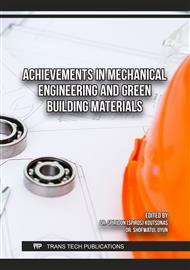[1]
International Energy Agency, "Global EV Outlook 2022," https://www.iea.org/reports/electric-vehicles, May 2022.
Google Scholar
[2]
Y. Zhao, O. Pohl, A.I. Bhatt, G.E. Collins, P.J. Mahon, T. Ruther, and A.F. Hollenkamp, "A Review on Battery Market Trends, Second-Life Reuse, and Recycling," Sustainable Chemistry, vol. 2, no. 1, p.167–205, Mar. 2021.
DOI: 10.3390/suschem2010011
Google Scholar
[3]
M.A. Rahman, I. Pranoto, "Review on Current Thermal Issue and Cooling Technology Development on Electric Vehicles Battery," 2020 6th International Conference on Science and Technology (ICST), Yogyakarta, Indonesia, 2020, pp.1-6.
DOI: 10.1109/ICST50505.2020.9732879
Google Scholar
[4]
J. Smith, R. Singh, M. Hinterberger, and M. Mochizuki, "Battery thermal management system for electric vehicle using heat pipes," International Journal of Thermal Sciences, vol. 134, p.517–529, Dec. 2018.
DOI: 10.1016/j.ijthermalsci.2018.08.022
Google Scholar
[5]
U. Chavan, O. Prajapati, and P. Hujare, "Lithium ion battery thermal management by using coupled heat pipe and liquid cold plate," Mater Today Proc, Jan. 2022.
DOI: 10.1016/j.matpr.2022.10.185
Google Scholar
[6]
H. A. Kose, A. Yildizeli, and S. Cadirci, "Parametric study and optimization of microchannel heat sinks with various shapes," Appl Therm Eng, vol. 211, Jul. 2022.
DOI: 10.1016/j.applthermaleng.2022.118368
Google Scholar
[7]
Y. Li, H. Guo, F. Qi, Z. Guo, M. Li, and L. Bertling Tjernberg, "Investigation on liquid cold plate thermal management system with heat pipes for LiFePO4 battery pack in electric vehicles," Appl Therm Eng, vol. 185, 2021.
DOI: 10.1016/j.applthermaleng.2020.116382
Google Scholar
[8]
Y. Wang, T. Gao, L. Zhou, J. Gong, and J. Li, "A parametric study of a hybrid battery thermal management system that couples PCM with wavy microchannel cold plate," Appl Therm Eng, vol. 219, Jan. 2023.
DOI: 10.1016/j.applthermaleng.2022.119625
Google Scholar
[9]
D. Bernardi, E. Pawlikowski, and J. Newman, "General Energy Balance for Battery Systems," Electrochemical Society Extended Abstracts, 1984.
DOI: 10.1149/1.2113792
Google Scholar
[10]
F. Rohman, "Aplikasi Graphene Untuk Lithium Ion Battery." Bandung: Institut Teknologi Bandung, 2012.
Google Scholar
[11]
S. Asri, "Rancang Bangun Fasilitas Eksperimen Sistem Pendinginan Berbasis Liquid Cold Plate untuk Baterai Lithium-Ion 18650 pada Kendaraan Listrik," Tugas Akhir Universitas Gadjah Masa, 2022.
Google Scholar
[12]
F. Dong, Z. Cheng, J. Zhu, D. Song, and J. Ni, "Investigation and optimization on cooling performance of a novel double helix structure for cylindrical lithium-ion batteries," Appl. Therm Eng, vol. 189, May 2021.
DOI: 10.1016/j.applthermaleng.2021.116758
Google Scholar
[13]
Device Solutions Business Group, "Lithium-Ion Rechargeable Battery Technical Information," https://www.powerstream.com/p/us18650vtc4.pdf. PowerStream Technology, p.2–9, 2012.
Google Scholar



